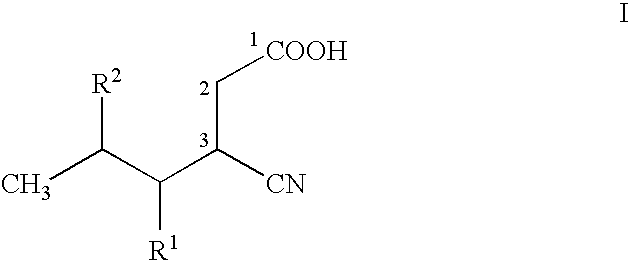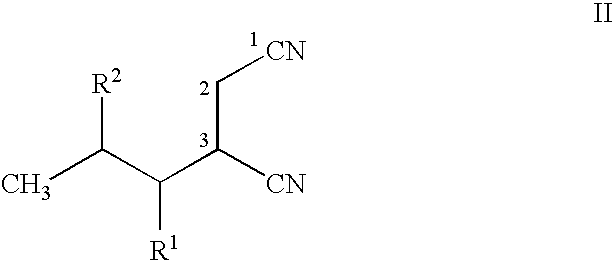Stereoselective bioconversion of aliphatic dinitriles into cyano carboxylic acids
a technology of cyanocarboxylic acid and dinitrile, which is applied in the direction of nervous disorder, organic chemistry, drug composition, etc., can solve the problems of unwanted by-products, incompatibility with compounds containing sensitive functional groups,
- Summary
- Abstract
- Description
- Claims
- Application Information
AI Technical Summary
Benefits of technology
Problems solved by technology
Method used
Image
Examples
example 1
Preparation of 2-isobutyl-succinonitrile
[0084] A mixture of ethyl cyanoacetate (73.3 g, 6.48 mol), isovaleraldehyde (613.9 g, 7.13 mol), piperidine (5.5 g, 0.065 mol), and hexane (0.5 L) was placed under reflux with continuous removal of water. When no additional water was collected, the mixture was cooled and distilled under vacuum to remove solvent. Isopropanol (1 L) was added to the remaining oil, followed by a solution of potassium cyanide (422 g, 6.48 mol) in water (2 L). The reaction mixture was maintained below 35° C. during addition of the potassium cyanide solution and then held at approximately 35° C. for 4 h. The reaction mixture was distilled at atmospheric pressure until a temperature of 95° C. was reached and then refluxed at this temperature for 5 h. The reaction mixture was cooled, diluted with water (0.5 L) and extracted with 1 L methyl tert-butyl ether (MTBE). The MTBE extract was washed with water (0.5 L), dried over anhydrous magnesium sulfate, filtered, and con...
example 2
Preparation of (S)-3-Cyano-5-methylhexanoic Acid from 2-isobutyl-succinonitrile with NIT-101, NIT-102. NIT-103, and Arabidopsis thaliana nitrilase
[0086] Three 8 mL screw-cap glass vials were each charged with 2-isobutyl-succinonitrile (20 mg), 1 mL of 50 mM potassium phosphate buffer (pH 7.5, 2 mM dithiothreitol (DTT)), and 10 mg of a nitrilase enzyme selected from NIT-101, NIT-102, or NIT-103 (Biocatalytics Inc., Pasadena, Calif.). One 8 mL screw-cap glass vial was charged with 2-isobutyl-succinonitrile (20 mg) and 1 mL of a solution of Arabidopsis thaliana nitrilase in 50 mM phosphate buffer (pH 7.8) containing 100 mM ethylenediaminetetraacetic acid (EDTA) and 2 mM DTT (Jülich Fine Chemicals, Jülich, Germany). The four reaction mixtures were stirred with magnetic stir-bars for 15 h at 30° C. and then individually extracted with ethyl acetate (2×6 mL). After removing the ethyl acetate extracts, the aqueous parts were treated with 4N HCl (0.15 mL) and extracted with ethyl acetate (...
example 3
Preparation of (S)-3-Cyano-5-methylh exanoic Acid from 2-isobutyl-succinonitrile with NIT-102
[0087] A 125 mL jacketed reaction vessel maintained at 30° C. was charged with 2-isobutyl-succinonitrile (3.33 g), NIT-102 (0.5 g) and 122 mL of 50 mM potassium phosphate buffer (pH 7.5) containing 5 mM DTT and 1 mM EDTA (reaction buffer). After stirring for 12.5 h, the product mixture was extracted with ethyl acetate (4×50 mL). The ethyl acetate extracts were removed, and the aqueous part was adjusted to pH 2.5 with 4M HCl and extracted with ethyl acetate (3×50 mL). The ethyl acetate extracts of the acidified aqueous part were combined, dried with anhydrous MgSO4, filtered, and concentrated under vacuum to give 1.56 g of (S)-CMHA (41.1%). A sample of the reaction product was treated with (trimethylsilyl)diazomethane and analyzed by GC as described in example 2 to reveal an enantiomeric purity of 98.5% e.e.
[0088]1H NMR (CDCl3, 400 MHz): δ 0.93-0.97 (m, 6H), 1.30-1.37 (m, 1H), 1.61-1.68 (m,...
PUM
| Property | Measurement | Unit |
|---|---|---|
| Electrical conductance | aaaaa | aaaaa |
Abstract
Description
Claims
Application Information
 Login to View More
Login to View More - R&D
- Intellectual Property
- Life Sciences
- Materials
- Tech Scout
- Unparalleled Data Quality
- Higher Quality Content
- 60% Fewer Hallucinations
Browse by: Latest US Patents, China's latest patents, Technical Efficacy Thesaurus, Application Domain, Technology Topic, Popular Technical Reports.
© 2025 PatSnap. All rights reserved.Legal|Privacy policy|Modern Slavery Act Transparency Statement|Sitemap|About US| Contact US: help@patsnap.com



